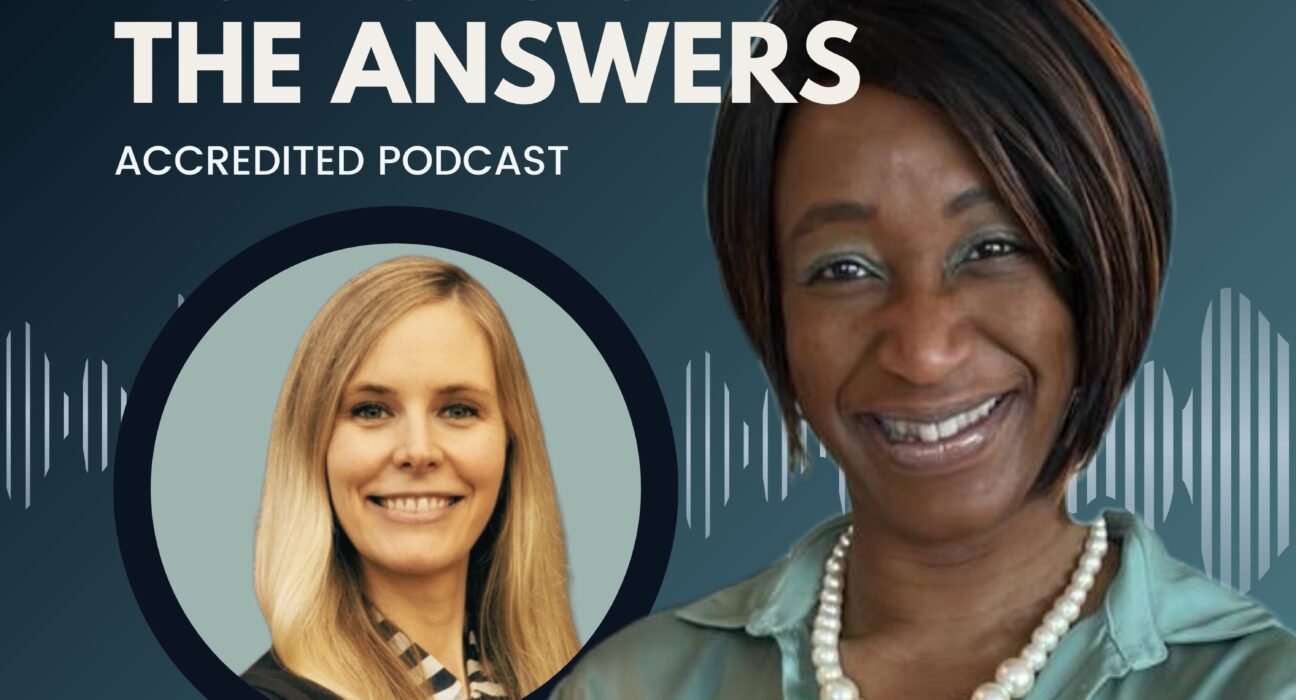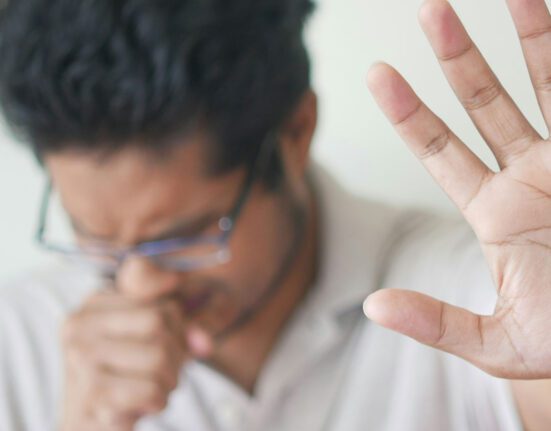
Amy Proal discusses the human microbiome’s complexity, emphasizing its role in health and disease. She explores how SARS-CoV-2 may disrupt microbiome balance, contributing to Long COVID symptoms. Additionally, Proal links Long COVID to ME/CFS, noting both conditions share symptoms but differ in their origins and manifestations.
Guest – Dr Amy Proal
Note: The podcast has no bias. All conflicts of interest are highlighted with individual guests.
Healthcare Professionals | Earn 0.5 Certified Mainpro+® Credits! Please register/login to claim your CPD/ CEU credits.
Podcast Overview:
In this insightful podcast, Amy Proal delves into the human microbiome’s intricate ecosystems and their crucial role in overall health. She explains how disruptions caused by SARS-CoV-2 may lead to Long COVID symptoms by affecting microbiome balance. Proal also examines the similarities and differences between Long COVID and ME/CFS, highlighting their overlapping symptoms and distinct origins..
Key Points:
- Human Microbiome: Diverse organisms in the human body impact health; imbalances (dysbiosis) can lead to chronic conditions.
- SARS-CoV-2 Impact: Disrupts microbiome balance, contributing to Long COVID symptoms by affecting immune regulation.
- Vagus Nerve Role: Links inflammation and symptoms like fatigue; may be directly infected by SARS-CoV-2.
- Long COVID vs. ME/CFS: Similar symptoms, but Long COVID is specific to SARS-CoV-2, while ME/CFS has broader infection triggers.
DISCLAIMER: The information in this podcast is provided for informational purposes only. You should not use any information discussed in this podcast and related materials to make medical or healthcare related decisions. Always consult a your physician or other qualified health care provider with regards to diagnosing managing your medical condition. Any medications or treatments, including any discussed in this podcast, should be initiated and managed by a qualified health care professional.
Podcast Transcript:
Healthcare Professionals: Please note to claim Certified CPD / CEU credits toward your medical license (Canada & reciprocal CPD/CEU Worldwide), you will need to register or log in.
Episode 13 – Long COVID & Other Viral Illnesses That Lead to Chronic Post Viral Illness (pt2) ft. Dr Amy Proal
[00:00:00] Funmi Okunola: The information in this podcast is provided for informational purposes only. You should not use any information discussed in this podcast and related materials to make medical or healthcare related decisions. Always consult your physician or other qualified healthcare providers with regards to diagnosing and managing your medical condition. Any medications or treatments, including any discussed in this podcast should be initiated and managed by a qualified healthcare professional
Funmi Okunola: Welcome to Long COVID – The Answers. Today’s Episode is entitled “Long COVID and Other Viral Illnesses That Lead to Chronic Post-Viral Illness” Part 2. I’d like to introduce Dr. Amy Proal. Dr. Proal is a microbiologist who studies how bacterial, fungal, and viral infections disrupt human gene expression, immunity, and metabolism.
Her research also examines how human microbiome disturbance can cause Chronic Inflammatory Illness. Dr. Proal is the President and [00:01:00] Chief Scientific Officer of PolyBio. Welcome, Amy.
Amy Proal: Thank you so much for having me.
Funmi Okunola: Amy, do you have any conflicts of interest to declare? No? Okay. Could you please tell us about other Chronic Diseases that are associated with viruses?
Amy Proal: Yes. I think that an important one to bring up is that there’s a condition called Myalgic Encephalomyelitis Chronic Fatigue Syndrome, and this is a condition and kind of symptom criteria-based diagnosis that people are given often after viral or other bacterial infections where patients don’t recover and become truly seriously ill, sometimes just completely bedridden.
In the history of ME/CFS links highly to viral infection and in some cases Chronic Viral Infection, especially the fact that there were in the 1950s and 1960s [00:02:00] actual outbreaks in different U. S. cities, sometimes in the U. K., even in Iceland – different areas in which patients became sick at the same time after an infection and were diagnosed with ME/CFS, this condition.
The really difficult part was that at those outbreaks, the technologies that people had were just not good enough to really be able to identify viruses, especially a novel virus that people might not know what it was. Also, there wasn’t much interest, which is really terrible, in investigating some of those outbreaks because they were very incorrectly deemed psychosomatic. I mean one of the silliest things that we have with these illnesses is, in some cases, women are affected more than men, and in some of these outbreaks, more women got sick, and there was this ridiculous attitude to say, “okay, well, they’re probably all just complaining”. So, no one really looked and actually tried very hard to look for viruses in these patients.
That’s getting a [00:03:00] little bit better now, but we really need to get over this idea that because sometimes women are more affected by the chronic consequences of infections, that it’s less serious. It’s very serious and utterly biologically driven. We don’t need any kind of psychological explanation.
What was interesting in these outbreaks is there was some work though that showed that they might be tied to the enteroviruses, which are a family of viruses that have many parallels to SARS-CoV-2, which is what makes them interesting. They’re a family of viruses that include the polio viruses.
People are probably familiar with polio as we know polio is a RNA virus driven illness in which some people get a kind of polio, the one we’re most familiar with and become paralyzed. That’s the classic form of polio. But what a lot of people don’t know is that there are different strains of the type of virus that drives polio and not all of them cause paralysis.
Many of them just cause other different also debilitating chronic disease states, but that are somewhat different, and [00:04:00] that’s the enterovirus family. In these ME/CFS outbreaks, there were people who found enterovirus genetic material in muscle samples from some of the patients, or even in some cases where there was an autopsy performed, in one or two instances, in the brain tissue or brainstem of these patients, and so that’s an instance in which now that’s almost reviving an interest in this enterovirus family as a driver of Chronic Symptoms after infection, and enteroviruses are like SARS-CoV-2 in which they’re acquired via respiratory infections.
For example, hand, foot, and mouth disease, a common illness that children often get in preschool, is one of the types of enterovirus infections that is just commonly out there that is not again looked at in terms of its possible chronic consequences. But these viruses often begin as respiratory infections and like SARS-CoV-2, often get into the gut as well,[00:05:00] thus the potential persistence of entero- viruses in the intestine. A little like SARS-CoV-2 it is able to persist there as we see growing data that there is a growing area of interest in better understanding these cases of ME/CFS. Again, that’s one connection where we’re looking at – a similar respiratory virus family and potentially driving a chronic condition similar to Long COVID that debilitates millions of patients across the globe.
But other than the fact that pathogens and viral pathogens are actually connected to also just some of the most widely recognized Chronic Conditions of our time. For example, Alzheimer’s disease. Alzheimer’s disease is increasingly tied to viral bacterial and even fungal infection of the brain tissue.
There’s a team that we work with that are collaborators at Harvard Medical School, and they’ve done research now for years showing that the Alzheimer’s plaque, the amyloid beta plaque [00:06:00] in their brain models, which are very sophisticated, actually functions as an anti-microbial peptide, which is part of the human immune system that forms in response to viruses or bacteria.
So, they can actually show that if they put a viral or bacterial pathogen into this neuron model, amyloid Alzheimer’s plaque forms around it, and that’s the reason that the plaque is being seeded. So again, these experiments need to be further verified. But there’s an explosion now in studying the general possibility that Alzheimer’s plaque could be seeded by viral infection.
In fact, we’re supporting a study right now through our foundation where a team is studying how Alzheimer’s plaque could form in response to SARS-CoV-2. There’s a huge number of cases of Alzheimer’s. Someone is diagnosed with Alzheimer’s, I think, almost every sixty-four seconds in the U.S. It’s a major crisis right now. [00:07:00] So, we should probably really be taking these connections to viral infection very seriously.
Beyond Alzheimer’s disease, Multiple Sclerosis is another condition that recently has been more clearly than ever tied to viral infection, in that case, with Epstein Barr virus, which I mentioned before. There are two big studies, one out of Stanford, one out of Harvard, really making a compelling case for Epstein Barr virus activity in MS. With the one from Stanford being, in my opinion, particularly interesting because what they showed is that in cerebrospinal fluid from patients with MS, they were able to show that the immune system targets an Epstein Barr virus protein called Ebne 1.
But that protein has a similar size and shape to a human neuron protein attacked by the immune system in MS. What it seems [00:08:00] like could be happening, and this is actually called molecular mimicry, it’s a known concept in chronic disease, is that the immune system is targeting human tissue, but the reason it is is because it’s first targeting a viral protein, the Epstein Barr protein, and because that protein is similar in size and shape, it just hits the human protein with the similar shape, almost as collateral damage. So, in other words that’s positioning infection at the heart of autoimmunity.
Funmi Okunola: Thank you. That’s an MS finding. The truth is that we have a growing number of chronic conditions that are increasingly tied to infection, and that is the truth. So, I see a whole new growth in the pharmaceutical industry with regards to antivirals. Yeah. As doctors we normally say antibiotics are for bacteria. If you get a virus, your body fights it. I think you’re beginning to turn that on its head really with everything that you’re saying today.
Amy Proal: Yes, I do think that that is [00:09:00] a hope of where the pharmaceutical industry will move, and I think that’s why, although it is scary to think about, and it’s just concerning to think about how viruses and other pathogens may really be at the root of so many chronic conditions and processes, it also gives us a very clear target to develop new drugs to make that stop.
I am a big proponent of the fact that I think one of the major government programs that we should be doing should be a rapid funding mechanism for companies and scientists who can develop new anti-viral or even anti-bacterial compounds, just a huge effort and the talent is there right now. A huge amount of understanding is there. We need to organize it, and we need to start to build it so that we have many, many more anti-virals because we really have a limited number of anti-virals right now considering the number of viruses that can make us sick. [00:10:00] Even for SARS-CoV-2 we have, it’s a good start, we have Paxlovid. Molnupiravir was out there. It should be way more. There should just be way, way more.
Funmi Okunola: Yeah, and also, I guess vaccine development is going to be one.
Amy Proal: Exactly, and the platforms for the vaccine we’ve got to think about I think is interesting. We have to definitely think about the delivery mechanisms and how, especially with the SARS-CoV-2 vaccines, they didn’t end up preventing transmission. So, we have to think about how we’re making these. For example, people propose nasal vaccines, which is an interesting thought. I think continued innovation on the technologies for potential vaccine platforms is important.
Funmi Okunola: Yeah. So, you basically want a vaccine that can prevent transmission as well as prevent serious illness and death, whereas at the moment we just have a vaccine in SARS-CoV-2, a way that prevents serious illness and death but not transmission.
Amy Proal: Yeah, [00:11:00] exactly. Transmission would be important and also to make sure that there are a certain number of patients that we see who have been dealing with side effects from the vaccine, to make sure that we really prioritize safety when it comes to the vaccines as well, and just really keep all of that in mind as we just continue to perfect them.
Funmi Okunola: Okay. Amy, what is the human microbiome?
Amy Proal: The human microbiome is a vast collection of organisms that lives in and on every person. We are basically seated with these interacting communities that are almost as robust as let’s say the rainforest. So, if you consider in the rain forest all the different animals there and how their relationships and the way they interact are all intertwined – for example, if one species dies off, it could have an impact on the other. Okay, that is also a characteristic of [00:12:00] these ecosystems of organisms that are in the human body. They’re ecosystems that are made of bacteria, fungi, and even interestingly, viruses that infect bacteria and modulate their activity that are called ‘bacteriophage’.
There are many of those. The truth is that we didn’t even totally know that humans harbored all these ecosystems of organisms until a couple of decades ago where the technologies that we used to find organisms in the human body or in most settings became much sharper and had the ability to find new genomes.
There was a revolution even almost just ten years ago in teams getting samples from the human body, from different parts of the body and sequencing them and saying, “Oh my gosh, we’re finding all these organisms in the sample that we didn’t even realize were here before!” It’s been a progression of understanding to realize that humans have these ecosystems in and on us, and [00:13:00] we’re still figuring out what that means. It’s definitely part of what they do. The gut is the most densely populated area of the human microbiome, and it’s probably where people are most familiar.
A lot of people now understand that there’s ecosystems of bacteria and other organisms in their gut that play a role in their digestion, that play a role in even how they metabolize drugs and other products, that gut microbiome is definitely important in not just food digestion, but even many of the organisms in the gut microbiome produce compounds, and those compounds, let’s say tryptophan, that are made by our gut bacteria, often participate in human cycling pathways. What that means is our human genes and the way our human cells work are actually very very closely connected to the activity of these interacting ecosystems of organisms in our gut and other body sites, because the compounds that they make become part of our human cycling, and then [00:14:00] vice versa, our human cycling impacts the way that the organisms survive.
So, some people actually refer to the human body now as a ‘superorganism’ or even as a ‘holobiont organism’, which means many genomes because the ultimate output of what we are and what we do as humans really is controlled at the end of the day by the activity of our human genes, but also by the activity of these trillions of organisms in and on us whose products and genes are also part of our collective metabolism.
So, what are these organisms? Bacteria are a major component, and then there’s also some fungal organisms in archaea, which are a type of organism that are similar to bacteria but a little bit of a different lineage. Again, they’re not necessarily driving disease, and in a way [00:15:00] they’re considered by some people to be friendly. If you had a rainforest scenario where obviously some animals eat others and there’s competition between animals, but as long as that’s happening in a state of balance, it’s basically being pulled off.
It’s similar with the organisms in us. So, you have the bacteria, the fungi, the archaea, and then as I mentioned before, the small viruses called ‘bacteriophage’ that infect the bacteria and affect the way that they act, and those bacteriophages are tiny and there’s many of them. There’re estimates that there are trillions, if not, and I’ve heard the number even quadrillions of these bacteriophages which is, I realize, hard to picture in us at any given time. I think the key there is that a little like Epstein Barr virus, so those latent viruses are kept in check by the human immune system, and thus the person functions fine.
There’s a similar dynamic with the human microbiome. [00:16:00] So you have these vast communities of the interacting bacteria and fungi and the bacteriophage that’s all in balance as long as the immune system is, again, keeping them in check and making sure that one type doesn’t overgrow and take over the whole community or anything like that. That’s how we stay in a state of health, but again if the immune system becomes disabled and you have problems with any kind of immune signaling to a point, you might lose that control over the microbiome, and then some of those bacterial or fungal organisms, we call them pathobionts, they have the capacity under conditions of immune suppression or stress to change their activity, and the way they express their genes in a way that they can now act as pathogens.
So, you have to be careful with the fact that these communities seem to be harmonious and even in some cases helpful under [00:17:00] conditions of balance, health, and good immune function. But if you lose that, they can also collectively shift towards a state of imbalance that’s called ‘dysbiosis imbalance’, and then that imbalance of those microbiome communities is being connected to a lot of, again, chronic problems.
Funmi Okunola: And that’s where SARS-CoV-2 comes in. It can cause an imbalance in our microbiome in the way you describe it.
Amy Proal: It’s that same idea where SARS-CoV-2 could, again, even when it knocks down that same interferon signaling or other parts of the immune response, then the immune system cannot control and keep the microbiome communities in check.
There can be overgrowth of detrimental pathogens. There might be leakage or movement of some of those organisms into tissue or body sites where they’re not supposed to be. You can have these community shifts, and then that itself exactly could also lead to [00:18:00] symptoms in the patient and be part of the Chronic Symptoms that they developed after the SAR-CoV-2 infection.
So that could be, in other words, Long COVID, and some of the patients that have a Long COVID diagnosis might be suffering from collective microbiome imbalances, especially in the gut where the microbiome community is so robust, and also potentially in the mouth. The mouth also has a really robust microbiome community. So, we focus a lot on the study of how SARS-CoV-2 infection and Long COVID might throw off the gut microbiome and the oral microbiome.
Funmi Okunola: Yeah, and I guess that would give some explanation as to why, correct me if I’m wrong, Long COVID presents with over two hundred different symptoms because we all have a unique microbiome which we’re born with. I guess my microbiome is different from say my Nigerian cousins because they’re born in a different environment. I might’ve been exposed to different things, in different walks of life. So, you can see, I guess how, if a [00:19:00] pathogen like SARS-CoV-2 virus comes in and disrupts that, I could express things in different ways.
Amy Proal: That is exactly right. At least that’s exactly how I see it, is that since we’re all set up with different microbiome communities to begin with, and since we all acquire different latent viruses over our lifetimes, when a pathogen like SARS-CoV-2 comes in and disrupts our immunity, the way that that manifests in each person is going to be somewhat different. That could definitely be why different patients have different kinds of Chronic Symptoms even though the same general processes are happening to all of them.
Funmi Okunola: Yeah. This is such a beautiful interview. Um, okay. Could you briefly touch on the vagus nerve and brainstem and how they might play a role in Long COVID symptoms?
Amy Proal: Sure. So, we have a very important nerve that runs throughout most of our major [00:20:00] organs and then connects to the back of the brain, and that nerve is called the ‘vagus nerve’. Vagus actually means ‘wanderer’. So, the nerve is named vagus because it wanders throughout our entire human body. What happens is it converges on every major trunk organ.
The vagus nerve innervates the gut, it innervates the heart, it innervates all these important organs, and when it’s there it has receptors at the end terminals of the nerve that sense inflammation, and if they sense inflammation, they convey that signal to the brainstem, (which is in that paper you mentioned – that 2021 paper), that has these overlapping nerve bodies that control very important responses or symptoms in people. One is the sickness behavior response, and that is a response that the brain mounts to let a person know that the body is sick.[00:21:00]
So, let’s say you have food poisoning. You ate something, you’re sick. Your brain has to know that that happens so that you stop eating the food poisoning food. What happens is the vagus nerve in the gut senses the inflammation from the food poisoning and goes, ah, it signals to the brain stem, and it says, “this is not good. You’re sick. You’re sick. You’re sick”, and that this nucleus in the brain signals flu like symptoms, malaise, tiredness, achiness, which are the manifestations of sickness, and that’s what is the sickness behavior response. So, you can understand that.
Let’s say you had a problem in your gut, but it didn’t go away. You have reservoir of the virus still in the gut that didn’t fully clear. It could be then that the vagus nerve keeps sensing that inflammation and keeps signaling to the brainstem and then keeps mounting that sickness behavior response with the fatigue and the malaise and the tiredness and those symptoms [00:22:00] continue in a person which are some of the most common symptoms that people have with Long COVID, right?
So, it helps explain if that were happening, why people feel fatigued and why they develop these symptoms of malaise and fatigue in the brainstem near the same nerve region that controls that sickness response. There’s also nerve bodies that control autonomic function which is, in simple terms, modulates our ability to move from a sitting to a standing position without getting super dizzy. We’re able to make the blood pressure changes needed to get up and entirely change how we are. That’s controlled by the autonomic nervous system. We see again in patients with Long COVID often that they struggle with that. So, patients develop what’s called Dysautonomia or problems where they cannot rise from sitting to standing without becoming incredibly dizzy.
They have a lot of trouble [00:23:00] regulating their blood pressure and autonomic function. So, it makes sense that there could be issues with the autonomic signaling in the brainstem, and then there’s also nerve bodies there that control pain and nausea. Overall, the big picture that we see is we think that a lot of study in Long COVID patients should be happening on the vagus nerve because that nerve connects to so many body sites and is able to influence those brain regions that control symptoms that are so common in many Long COVID patients. The way again that that might happen is that the vagus nerve could be sensing, for example, persistent reservoirs of virus, and that could be one of the reasons that the nerve is changing its signaling and potentially being impacted to contribute to symptoms. Also, though, it’s not impossible that the vagus nerve could be directly infected, for example by SARS-CoV-2, maybe even in a persistent state.
There was an autopsy study of patients with Acute [00:24:00] COVID, and they got vagus nerve tissue from people who passed away from COVID, and one team found SARS-CoV-2 RNA in every single vagus nerve sample from patients in that study – every single person! The virus had gotten directly into that vagus nerve. So, one thing, again, that we’re trying to study and think about is what if the virus is just in the vagus nerve? That would be the most straightforward explanation for why that sickness response and the autonomic symptoms and other symptoms were manifesting at least in certain patients, so it’s an interesting pathway that we’re looking at highly in Long COVID.
Funmi Okunola: Again, if you could answer briefly, because we’re nearly out of time – Long COVID appears to be almost equivalent to the 2015 case definition of ME/CFS provided by the Institute of Medicine. In your opinion, is Long COVID the same as ME/CFS? If not, [00:25:00] why not?
Amy Proal: I’ve heard people say that, but that’s an oversimplified way to think about it. If you ask me, I think that ME/CFS is a diagnosis that was known to exist before the COVID pandemic even happened. So, we know that patients can get sick after other infections, like I mentioned before, the enterovirus infections, and sometimes even the Herpes Viruses have been implicated in ME/CFS cases. So, then we have SARS-CoV-2 and people developing Long COVID after COVID. I think what people are trying to talk about when they’re comparing Long COVID and ME/CFS are that people, patients often develop common symptoms. So, the symptoms that many of the patients develop with Long COVID can often meet the questionnaire criteria for the symptoms that people had with ME/CFS before. What this really all [00:26:00] means to me is that different pathogens can likely affect similar or disregulate similar pathways in different patients, and that SARS-CoV-2 may be, for example, let’s say, disrupting vagus nerve signaling, potentially even infecting the vagus nerve in a way that leads to certain symptoms in Long COVID patients, and maybe in a patient with an ME/CFS diagnosis, a different virus infected or disregulated the vagus nerve in a way that led to similar symptoms in them.
So, it’s not really the case to me that Long COVID is ME/CFS or that either of those things are happening as much as the understanding that patients probably can experience similar dysregulation of pathways and processes by different pathogens, and that’s the key trend that we need to take away from [00:27:00] the similarities between those two patient populations.
Funmi Okunola: Okay. Well, we’ve come to the end of time, and I just wanted to say, thank you, Amy, for taking part in an excellent interview and for all the work you and the team do at PolyBio, and thanks again to our audience for joining us today.
Amy Proal: Thank you. Thanks for having me. [00:28:00]
Funmi Okunola: Some questions for listeners to consider.
What are your top five takeaways from this Episode?
How will this Episode change your practice or perception of this disease?
What will you do to act on what you’ve learned?
Please discuss your thoughts on our social media outlets such as Twitter or X, our website blog, Instagram, Facebook, LinkedIn.
Please rate this episode.
SHOW NOTES:
Dr Amy Proal, Microbiologist, President and Chief Scientific Officer of Polybio discusses Long COVID in the context of other viral illnesses that lead to Chronic Post Viral Illness. This is part 2 of a 2 part series.
REFERENCES
1. Polybio








